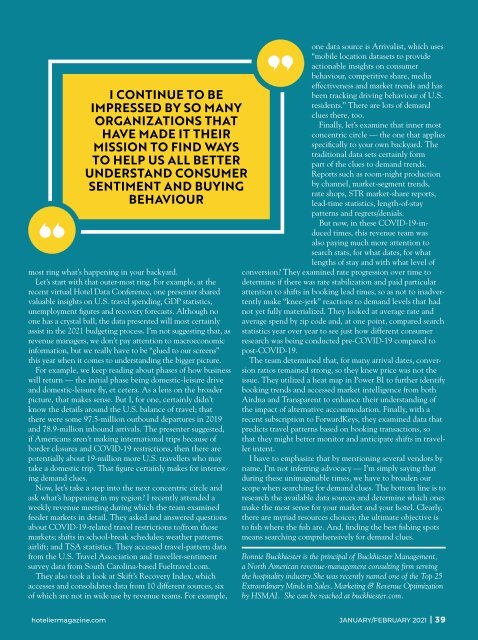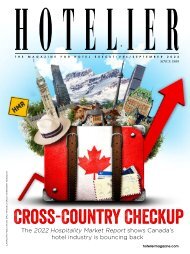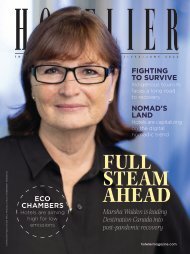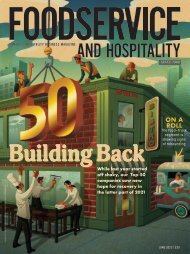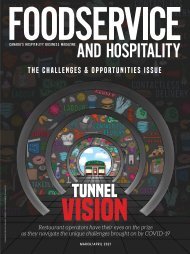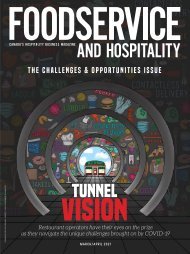January/February 2021
issue.
issue.
Create successful ePaper yourself
Turn your PDF publications into a flip-book with our unique Google optimized e-Paper software.
I CONTINUE TO BE<br />
IMPRESSED BY SO MANY<br />
ORGANIZATIONS THAT<br />
HAVE MADE IT THEIR<br />
MISSION TO FIND WAYS<br />
TO HELP US ALL BETTER<br />
UNDERSTAND CONSUMER<br />
SENTIMENT AND BUYING<br />
BEHAVIOUR<br />
most ring what’s happening in your backyard.<br />
Let’s start with that outer-most ring. For example, at the<br />
recent virtual Hotel Data Conference, one presenter shared<br />
valuable insights on U.S. travel spending, GDP statistics,<br />
unemployment figures and recovery forecasts. Although no<br />
one has a crystal ball, the data presented will most certainly<br />
assist in the <strong>2021</strong> budgeting process. I’m not suggesting that, as<br />
revenue managers, we don’t pay attention to macroeconomic<br />
information, but we really have to be “glued to our screens”<br />
this year when it comes to understanding the bigger picture.<br />
For example, we keep reading about phases of how business<br />
will return — the initial phase being domestic-leisure drive<br />
and domestic-leisure fly, et cetera. As a lens on the broader<br />
picture, that makes sense. But I, for one, certainly didn’t<br />
know the details around the U.S. balance of travel; that<br />
there were some 97.5-million outbound departures in 2019<br />
and 78.9-million inbound arrivals. The presenter suggested,<br />
if Americans aren’t making international trips because of<br />
border closures and COVID-19 restrictions, then there are<br />
potentially about 19-million more U.S. travellers who may<br />
take a domestic trip. That figure certainly makes for interesting<br />
demand clues.<br />
Now, let’s take a step into the next concentric circle and<br />
ask what’s happening in my region? I recently attended a<br />
weekly revenue meeting during which the team examined<br />
feeder markets in detail. They asked and answered questions<br />
about COVID-19-related travel restrictions to/from those<br />
markets; shifts in school-break schedules; weather patterns;<br />
airlift; and TSA statistics. They accessed travel-pattern data<br />
from the U.S. Travel Association and traveller-sentiment<br />
survey data from South Carolina-based Fueltravel.com.<br />
They also took a look at Skift’s Recovery Index, which<br />
accesses and consolidates data from 10 different sources, six<br />
of which are not in wide use by revenue teams. For example,<br />
one data source is Arrivalist, which uses<br />
“mobile location datasets to provide<br />
actionable insights on consumer<br />
behaviour, competitive share, media<br />
effectiveness and market trends and has<br />
been tracking driving behaviour of U.S.<br />
residents.” There are lots of demand<br />
clues there, too.<br />
Finally, let’s examine that inner most<br />
concentric circle — the one that applies<br />
specifically to your own backyard. The<br />
traditional data sets certainly form<br />
part of the clues to demand trends.<br />
Reports such as room-night production<br />
by channel, market-segment trends,<br />
rate shops, STR market-share reports,<br />
lead-time statistics, length-of-stay<br />
patterns and regrets/denials.<br />
But now, in these COVID-19-induced<br />
times, this revenue team was<br />
also paying much more attention to<br />
search stats, for what dates, for what<br />
lengths of stay and with what level of<br />
conversion? They examined rate progression over time to<br />
determine if there was rate stabilization and paid particular<br />
attention to shifts in booking lead times, so as not to inadvertently<br />
make “knee-jerk” reactions to demand levels that had<br />
not yet fully materialized. They looked at average rate and<br />
average spend by zip code and, at one point, compared search<br />
statistics year over year to see just how different consumer<br />
research was being conducted pre-COVID-19 compared to<br />
post-COVID-19.<br />
The team determined that, for many arrival dates, conversion<br />
ratios remained strong, so they knew price was not the<br />
issue. They utilized a heat map in Power BI to further identify<br />
booking trends and accessed market intelligence from both<br />
Airdna and Transparent to enhance their understanding of<br />
the impact of alternative accommodation. Finally, with a<br />
recent subscription to ForwardKeys, they examined data that<br />
predicts travel patterns based on booking transactions, so<br />
that they might better monitor and anticipate shifts in traveller<br />
intent.<br />
I have to emphasize that by mentioning several vendors by<br />
name, I’m not inferring advocacy — I’m simply saying that<br />
during these unimaginable times, we have to broaden our<br />
scope when searching for demand clues. The bottom line is to<br />
research the available data sources and determine which ones<br />
make the most sense for your market and your hotel. Clearly,<br />
there are myriad resources choices; the ultimate objective is<br />
to fish where the fish are. And, finding the best fishing spots<br />
means searching comprehensively for demand clues.<br />
Bonnie Buckhiester is the principal of Buckhiester Management,<br />
a North American revenue-management consulting firm serving<br />
the hospitality industry.She was recently named one of the Top 25<br />
Extraordinary Minds in Sales, Marketing & Revenue Optimization<br />
by HSMAI. She can be reached at buckhiester.com.<br />
hoteliermagazine.com JANUARY/FEBRUARY <strong>2021</strong> | 39


